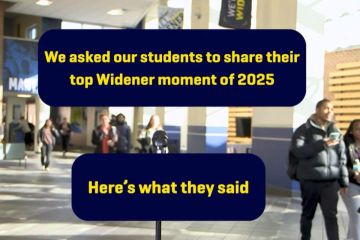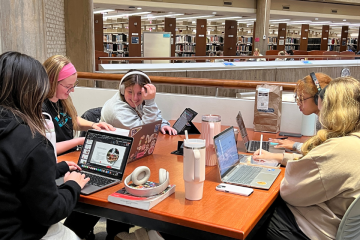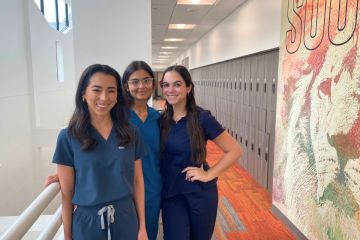Saving the Planet: Widener Faculty and Student Research Makes an Impact

The United Nations calls climate change the “defining issue of our time.”
Not a week passes without news of its impact—unprecedented heat waves and more frequent catastrophic storms; melting ice caps and rising sea levels threatening low-lying communities; poor air quality and the proliferation of disease; destruction of ecosystems; and risks to the global food supply.
The list of direct and indirect impacts is long, costly, and potentially life threatening.
Climate change has mobilized scientists, world leaders, entrepreneurs, and ordinary citizens. From global summits to city streets comes the rallying cry for action to stem the tide and reverse the effects already being felt.
In short, it’s a fight to save the planet before it’s too late. At Widener University, faculty and student researchers are doing their part.
Biology Professor David Coughlin and his students are examining the effects of warming stream temperatures on Atlantic salmon and Pennsylvania brook trout and the ability of these fish to acclimate.
“Brook trout could be the canary in the coal mine,” said Coughlin. “It’s an important predator in the system,” and losing the population could create a domino effect.
In a different field, Assistant Nursing Professor Karen May is studying whether school nurses are prepared to deal with illnesses related to climate change, such as asthma.
“This affects kids’ health and impacts their academic performance,” said May.
From social work to business, environmental science to engineering, Widener student-faculty teams are contributing to the growing body of climate and environmental research, exploring ways to effectively address the issues and push the planet toward a healthier, greener, and more sustainable future.
The scope of the climate change problem is so overwhelming. It’s an accelerating curve. We all need a seat at the table. — Social Work Professor Stephen Kauffman.
Preparing Social Workers to Help Climate Victims
Stephen Kauffman’s interest in the environment stems from his time living in Florida where he watched the degradation of waterways and fish populations. As a social worker in the field, he has helped communities address the fallout from environmental-related issues, including those associated with trash dumps and nuclear power plants.
As an educator, he brings the environment into his classroom in an effort to prepare the next generation of social workers to follow his lead.
Social workers may not seem like obvious foot soldiers in the climate change fight, but they have long been on the frontlines of disaster relief, public health crises, and environmental justice.
“You can’t understand or effectively work with clients unless you understand what’s going on with the individual and with the world around them and the interaction between,” said Kauffman, who teaches an environmental health policy course.
Due to increasing climate change consequences, social workers will be in even greater demand to help populations grapple with the psychosocial consequences of a changing physical world, said Kauffman. They will be needed to assist climate change refugees displaced by acute and prolonged events and help address the stress, depression, anxiety, and addiction that may follow.
Social workers will also continue to advocate for clean water, safe food, medical services, environmental protections, and policy changes, especially on behalf of disenfranchised populations, which are disproportionally impacted by environmental issues in general and climate change in particular, said Kauffman.
“We need to prepare social workers with the basic skills and enough knowledge that they’re not caught flat-footed,” said Kauffman, who believes the trauma-focused model of Widener’s master of social work (MSW) program is an inroad to addressing these issues.
But are would-be social workers across the country actually being prepared to face climate change consequences and effectively help their clients? That’s what Kauffman’s doctoral student Sara Strayer is trying to assess in her dissertation work.
Strayer, who also earned her MSW from Widener in 2009, is surveying 750 faculty members from MSW programs nationwide about how they address environmental justice in their curricula. How are educators delivering content? How are they assessing student-learning outcomes?
Climate change-related questions are built into her survey.
As social workers, we have a responsibility to engage in environmental justice and advocate for those vulnerable to climate change and other environmental issues. Social workers need to be aware of these issues and be prepared to address them. — Sara Strayer, PhD candidate
As a former caseworker for child protective services, Strayer, an adjunct instructor in Widener’s online MSW program, has witnessed firsthand the impact of environmental hazards on families.
“We can’t be ignoring these issues,” she said.
Helping Businesses Reduce Their Environmental Impact
In an office in Quick Center, home of the School of Business Administration, Jeremy Hancher answers a hotline. On the other end of the call is a small business owner with a question about environmental compliance.
“It’s the last thing small business owners are thinking about,” said Hancher, noting some calls come through the hotline because a business has landed in hot water with the Pennsylvania Department of Environmental Protection (DEP) or another regulatory agency.
Businesses are subject to a host of state and federal environmental regulations governing everything from emissions to storm water runoff. It’s Hancher’s job as program manager of the Environmental Management Assistance Program (EMAP) at Widener to help businesses meet these rules.
As part of Widener’s Small Business Development Center, EMAP works in partnership with DEP to offer small businesses free, one-on-one assistance. Hancher and his colleagues, which include Widener student interns, perform on-site assessments. They help clients understand the often-weighty regulations, calculate their emissions, implement measures to reduce pollution, attain necessary permits, and find ways to fund energy-efficient improvements.
EMAP’s clients represent all sectors of the economy, from manufacturing to agriculture to retail. And while small businesses are not typically the worst polluters, they do leave a footprint.
We’re indirectly tackling climate change. We’re helping small businesses keep on top of environmental issues and reduce emissions. — Jeremy Hancher, program manager, Environmental Management Assistance Program
Widener was selected in a competitive grant process to manage the statewide EMAP program, and the university subcontracts with the University of Pittsburgh and Shippensburg University to ensure statewide service coverage.
In 2018, EMAP educated more than 2,200 small businesses on regulations, helped 253 businesses with compliance issues, and made 42 site visits.
Searching for Signs of Climate Change in the Amazon
For the last 25 years, Environmental Science and Biology Professor Stephen Madigosky, accompanied by Widener students and other faculty, has been journeying to a research station deep in the heart of Peru’s Amazon rainforest.
The station is remote, accessible only by a five-hour, 100-mile speedboat ride down the Amazon River and its meandering tributaries. A dense jungle of trees 160-feet high awaits the travelers upon arrival. The canopy is so thick that during the day it can feel like perpetual dusk on the ground.
The researchers spend their days in the sky, working along one of the world’s longest canopy walkways—1,640 feet in length—which provides treetop access to study the area’s unique biodiversity and microclimates.
Madigosky has set up monitors to collect continuous data on temperature, rainfall, and humidity. It’s an area unspoiled by development and represents one of the most stable environments on the planet.
The problem is that its stability is faltering.
Madigosky and his students are starting to notice unusual occurrences in this microclimate. For example, during the past rainy season, the area didn’t see a drop of rain for weeks on end. Plants are beginning to alter their flowering and fruiting patterns. And during a visit this past July, as a result of unusual flooding, they could easily transport their gear to and from field sites by boat where in the past they had to carry in their equipment.
“We’ve noticed that consistency, to some degree, has begun to deteriorate. We’re beginning to see the first signs of a greater degree of irregularity,” said Madigosky. “We’re trying to evaluate the long-term cycles to determine if alterations or unusual patterns are conclusively beginning to occur.”
Other researchers are looking at Madigosky’s data with similar questions in mind. There are very few long-term studies like his out there, and his data is in high demand. Researchers from the Detroit Zoo, for instance, have requested his stats to assist in a study of tropical lizards from Peru, looking at a possible connection between the population’s dynamics and climate change. Other researchers have used his data sets to evaluate insect behavior and population dynamics within the Amazon Basin.
Madigosky is also preparing to publish further findings, with generations of Widener students as co-authors.
His next data set will look at the possible effects from the forest fires that began burning this past summer in the Brazilian Amazon. While the fires occurred hundreds of miles from his research site, distance and borders don’t keep environmental damage at bay. Madigosky and his students have seen this firsthand, witnessing spectacular sunsets in Peru caused by dust storms originating in the Sahara Desert in Africa, which churns up particulates in the upper atmosphere.
“The more we know, the more we realize the intricate nature of this small little planet we call Earth,” said Madigosky.
For environmental science major Lauren Schnell ’21, an aspiring biologist, traveling to Peru was a transformational experience and a chance to be part of something bigger.
“Our actions may seem small. We’re looking at tree number six in this dense forest. That may not seem like it matters, but it does,” said Schnell. “How does this tree represent the whole forest, the whole country, the whole world?"
Being part of this research, looking at the profound impacts of climate change—this the most beneficial thing I’ve done while at Widener. — Lauren Schnell '21
Engineering Solutions to Manage Waste
Solving the climate crisis will inevitably require new and innovative technologies. Enter the engineers.
“Certainly, with global warming, engineers are going to have to design solutions, whether it’s windmills, solar arrays, or increased efficiency of devices,” said Ronald Mersky, associate professor and chair of civil engineering. “Engineers, everywhere, will be involved in solutions to the environmental problem.”
And that includes engineers at Widener. For the last couple of years, Mersky has been advising senior project groups looking at ways to make waste management more environmentally friendly.
The groups have been partnering with a company called Underground Refuse Systems, which supplies subterranean trash bins to municipalities. While part of these receptacles rest above ground to receive trash, the bulk of the storage is beneath the surface. When full, collection trucks with mechanical arms lift the units out of the ground. A door at the bottom of each unit opens and trash is dumped directly into the truck.
These units are so large that trash pickup is needed less frequently, reducing traffic and vehicle emissions. The units are also intended to cut back on other nuisances, including spillage, odors, rodent problems, and aesthetic concerns.
The Widener students have helped the company showcase its product by developing a user-friendly model for interested communities to determine if these systems are right for them, and by creating an installation manual for placing new units.
“We looked at how air pollutants would be changed using this system. We looked at carbon dioxide emissions from trucks, which is a greenhouse gas, and greenhouse gases cause climate change,” said alumna Serena Turco ’19, a member of the senior project team in 2018-19. “The team looked at how much money could be saved by municipalities.”
While solid waste is not the worst greenhouse pollutant, and these underground containers may have only a small impact overall, every little bit helps. And that’s not lost on the Widener students and now-alumni who worked on the project.
“Even something small, like marketing this, can impact climate change,” said Megan Cullison ’19, who served as team leader for the project in 2018-19. “It could have a domino effect. Everything is intertwined.”



